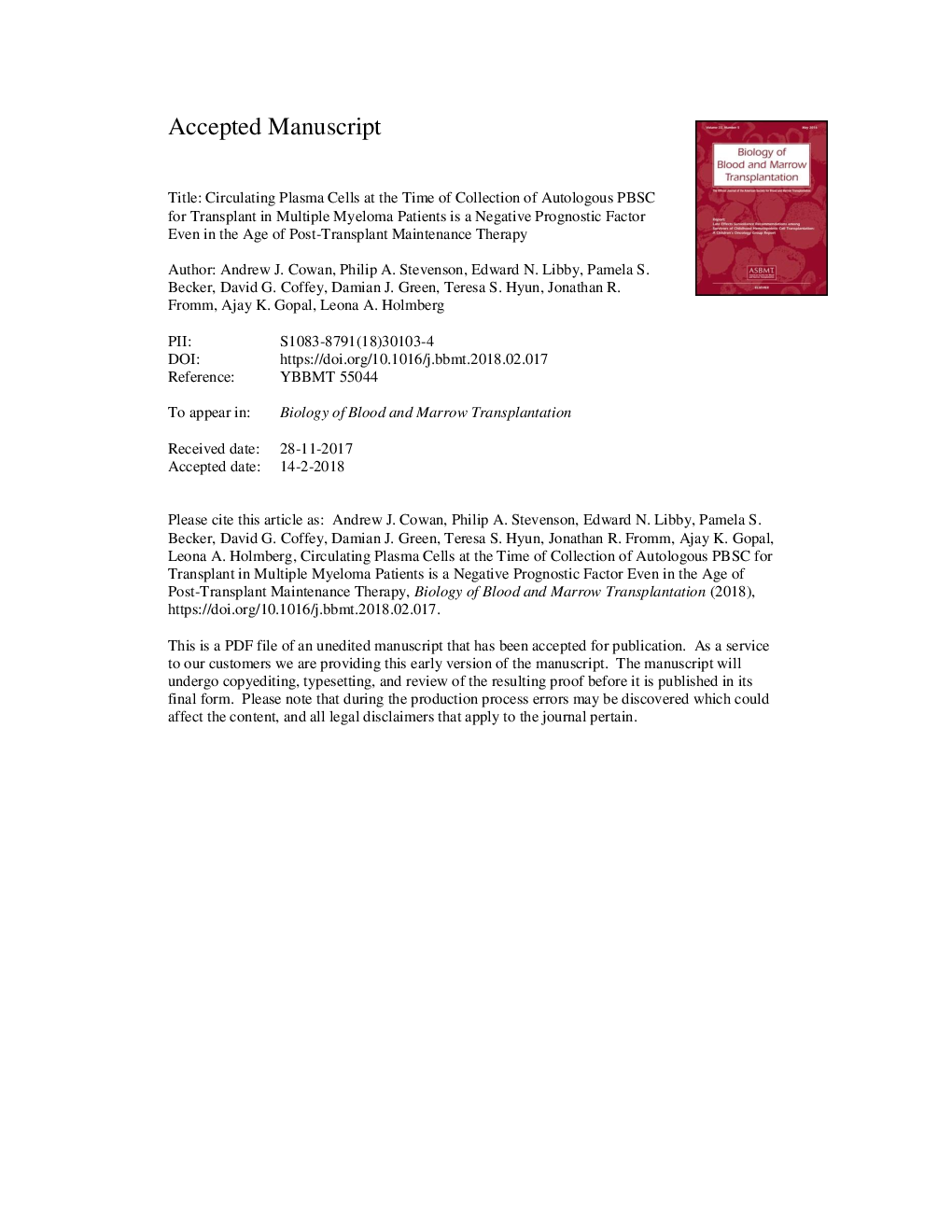| کد مقاله | کد نشریه | سال انتشار | مقاله انگلیسی | نسخه تمام متن |
|---|---|---|---|---|
| 8429709 | 1546226 | 2018 | 26 صفحه PDF | دانلود رایگان |
عنوان انگلیسی مقاله ISI
Circulating Plasma Cells at the Time of Collection of Autologous PBSC for Transplant in Multiple Myeloma Patients is a Negative Prognostic Factor Even in the Age of Post-Transplant Maintenance Therapy
دانلود مقاله + سفارش ترجمه
دانلود مقاله ISI انگلیسی
رایگان برای ایرانیان
کلمات کلیدی
موضوعات مرتبط
علوم زیستی و بیوفناوری
بیوشیمی، ژنتیک و زیست شناسی مولکولی
تحقیقات سرطان
پیش نمایش صفحه اول مقاله

چکیده انگلیسی
Circulating plasma cells (CPCs) have been detected in patients with multiple myeloma (MM) at various stages of disease and associated with worse outcomes. Little data exist regarding the impact of CPCs at the time of autologous peripheral blood stem cell (PBSC) collection on outcomes, and the impact of maintenance therapy after autologous stem cell transplantation (ASCT) on prognosis in patients with CPC-containing collections. All patients with MM who underwent first ASCT at Fred Hutchinson Cancer Research Center from 2012 to 2015 and had evaluation for CPCs at the time of PBSC collection were included in our analysis. Seven-color flow cytometry was used to detect the presence of CPCs. Kaplan-Meier estimates were used to generate overall survival (OS) and progression-free survival (PFS) rates from the time of ASCT. A multivariate analysis, including receipt of maintenance therapy post-ASCT, high-risk cytogenetics, and international staging system (ISS) stage, was included in a Cox proportional hazards regression model for associations with OS and PFS. We identified 227 patients with MM who underwent ASCT; of these, 144 (63.4%) patients had routine assessment of CPCs at the time of PBSC collection. One hundred seventeen (81.3%) patients did not have CPCs and 27 (18.8%) did have CPCs. The presence of CPCs was highly associated with poorer PFS (Pâ=â.031 by log-rank analysis), but did not affect OS. The median PFS for those patients without CPCs was 39.4 months (95% confidence interval [CI], 31.1 to not reached), while the median PFS for those patients with CPCs was 16.5 months (95% CI, 13.7 to not reached). A subgroup analysis of patients achieving very good partial response (VGPR) or better at time of collection, showed the median PFS for patients without CPCs was 38.3 months (95% CI, 29 to not reached), as compared with those patients with CPCs, where it was only 16.5 months (95% CI, 12 months to not reached; Pâ=â.02). There was no statistically significant difference in PFS or OS among those patients achieving partial response at the time of collection. In a Cox proportional hazards model, adjusting for post-ASCT maintenance therapy, high-risk cytogenetics, and ISS stage at time of initial diagnosis, there was a 43% higher risk of progression or death among the patients with CPCs (Pâ=â.04). The presence of CPCs at the time of autologous PBSC collection is a negative prognostic factor for risk of early relapse or death despite the advent of novel agents and maintenance strategies. The impact of CPCs was most significant among patients achieving a VGPR or better at time of collection. The presence of CPCs denotes a unique group of high-risk MM patients for whom alternative treatment strategies are needed to overcome resistance to current standard therapies.
ناشر
Database: Elsevier - ScienceDirect (ساینس دایرکت)
Journal: Biology of Blood and Marrow Transplantation - Volume 24, Issue 7, July 2018, Pages 1386-1391
Journal: Biology of Blood and Marrow Transplantation - Volume 24, Issue 7, July 2018, Pages 1386-1391
نویسندگان
Andrew J. Cowan, Philip A. Stevenson, Edward N. Libby, Pamela S. Becker, David G. Coffey, Damian J. Green, Teresa S. Hyun, Jonathan R. Fromm, Ajay K. Gopal, Leona A. Holmberg,